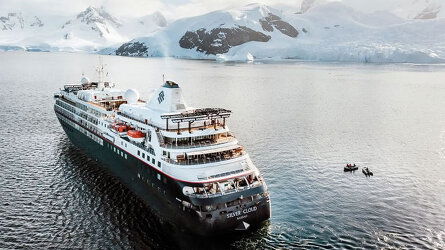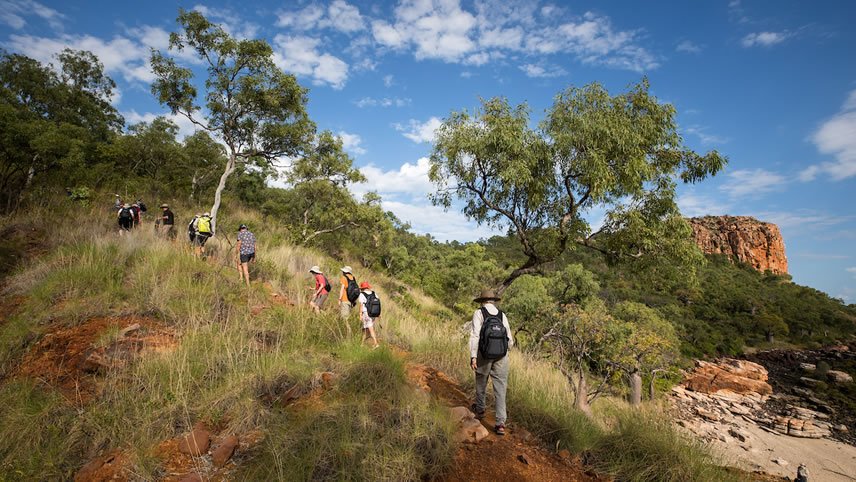Overview
Cruise Itinerary
Australia's only tropical capital city, Darwin is rich in culture and ethnically diverse. While the Northern Territory boasts some of the most incredible wildlife on the planet, the city's museums celebrate the city's past and the galleries showcase the region's rich indigenous art. Ships will dock at Fort Hill Wharf.
Top Things to Do in Darwin:
- cruise the Darwin Harbour
- explore Litchfield or Kakadu National Park
- visit the Museum and Art Gallery of the Northern Territory
- take a Jumping Crocodile Cruise
- visit the Darwin Botanic Gardens
The King George River, located in the remote Kimberley region of Western Australia, is renowned for its dramatic landscapes and pristine wilderness. The river is famous for the towering King George Falls, one of Australia's tallest waterfalls, where twin cascades plunge 80 meters into a gorge. A boat tour or scenic flight offers breathtaking views of this natural spectacle.
The river’s untouched environment is home to diverse wildlife, including saltwater crocodiles and numerous bird species. Exploring the river by boat allows visitors to appreciate the stunning red sandstone cliffs and lush vegetation.
Swift Bay, located in the remote Kimberley region of Western Australia, is renowned for its breathtaking natural beauty and ancient Aboriginal rock art. The bay's rugged coastline, with dramatic cliffs and secluded beaches, offers a pristine escape from the modern world. A key attraction of Swift Bay is its remarkable collection of Aboriginal rock art, depicting animals, human figures, and traditional symbols. These ancient artworks provide valuable insights into the lives of the Indigenous people who have inhabited the area for thousands of years.
Accessible primarily by boat, Swift Bay remains largely untouched, allowing visitors to experience the raw, unspoiled beauty of the Kimberley. Its combination of cultural heritage and natural splendour makes Swift Bay a unique destination in Western Australia.
Ashmore Reef, a remote coral atoll in the Timor Sea off the northwest coast of Australia, is a protected marine park renowned for its biodiversity and significance as a breeding ground for seabirds and marine life. This isolated reef complex comprises several sand cays surrounded by vibrant coral gardens that teem with an array of sea creatures including turtles, reef sharks, and countless species of tropical fish.
Access to Ashmore Reef is highly regulated to protect its delicate ecosystems, with visits typically by Zodiac excursion. Experience a unique opportunity to view the natural beauty and marine diversity of the reef without disturbing the habitat; a pristine example of marine conservation in action.
Adele Island in the Kimberley region of Australia is a small, uninhabited atoll known for its significant bird and marine life. This remote sanctuary is encircled by vibrant coral reefs and serves as a breeding ground for various seabird species and a resting spot for migratory birds. The surrounding waters are also rich with marine biodiversity, including turtles and reef sharks, making it a prime spot for wildlife enthusiasts.
As a protected nature reserve, Adele Island is accessible only by permission, and is coordinated by your cruise hosts to focus on ecological exploration. Visitors get a rare opportunity to observe untouched natural habitats and marine ecosystems up close, making it an exceptional destination for those looking to connect with nature’s pristine beauty.
The Buccaneer Archipelago, located off the northern coast of Western Australia, is a hidden gem comprising over 800 rugged islands.
This secluded paradise is famed for its dramatic red rock formations and pristine white sand beaches, set against the vivid turquoise of the Indian Ocean. The archipelago is relatively untouched, offering a sense of seclusion and raw natural beauty that is hard to find elsewhere.
Accessible primarily by boat, the region is a hotspot for adventurous travellers looking to explore its secluded bays and secret waterways. The tidal phenomenon known as the Horizontal Falls in Talbot Bay is a highlight, where rushing water creates a breathtaking natural spectacle.
The Buccaneer Archipelago, located off the northern coast of Western Australia, is a hidden gem comprising over 800 rugged islands.
This secluded paradise is famed for its dramatic red rock formations and pristine white sand beaches, set against the vivid turquoise of the Indian Ocean. The archipelago is relatively untouched, offering a sense of seclusion and raw natural beauty that is hard to find elsewhere.
Accessible primarily by boat, the region is a hotspot for adventurous travellers looking to explore its secluded bays and secret waterways. The tidal phenomenon known as the Horizontal Falls in Talbot Bay is a highlight, where rushing water creates a breathtaking natural spectacle.
Hunter River in Western Australia’s remote Kimberley region offers an extraordinary blend of rugged beauty and rich wildlife. This secluded area, accessible mainly by sea, features towering sandstone cliffs and cascading waterfalls. The river's tranquil waters are perfect for leisurely cruises, providing opportunities to spot saltwater crocodiles and an array of bird species.
Explore the ancient Indigenous rock art sites that dot the landscape, offering a glimpse into the region’s deep cultural heritage. The surrounding wilderness is home to diverse flora and fauna, making guided bushwalks a must for nature enthusiasts. Hunter River promises a captivating experience, combining breathtaking scenery with fascinating wildlife and cultural insights.
Jar Island contains ancient rock art galleries depicting the Gwion Gwion style unique to the Kimberley region. Mainly neglected by, or unknown to, the early European researchers of Aboriginal culture in the Kimberley in favour of the dominant and more dramatic Wandjina art, Gwion Gwion art has in recent years gained world prominence.
It is generally thought that this art may extend back to over 30,000 years before our time and represents the first wave of seagoing colonisers of the Australian continent. As it is, these are the oldest detailed depiction of human figures in the world. Join your Expedition Team ashore for a short walk, past some fascinating rock formations, to the site of the Gwion Gwion art galleries.
Days at sea are the perfect opportunity to relax, unwind and catch up with what you’ve been meaning to do. So whether that is going to the gym, visiting the spa, whale watching, catching up on your reading or simply topping up your tan, these blue sea days are the perfect balance to busy days spent exploring shore side.
Australia's only tropical capital city, Darwin is rich in culture and ethnically diverse. While the Northern Territory boasts some of the most incredible wildlife on the planet, the city's museums celebrate the city's past and the galleries showcase the region's rich indigenous art. Ships will dock at Fort Hill Wharf.
Top Things to Do in Darwin:
- cruise the Darwin Harbour
- explore Litchfield or Kakadu National Park
- visit the Museum and Art Gallery of the Northern Territory
- take a Jumping Crocodile Cruise
- visit the Darwin Botanic Gardens
Life Onboard Silver Cloud

Explore remote corners of the world on an expedition cruise in ultra all suite luxury. Read more

Enjoy all suite accommodation with luxury amenities and impeccable service provided by your own butler. Read more

Even an iPhone user can join expert classes and create professional images in the photo studio. Read more

Even on expedition cruises you will enjoy best in class service from the Silversea crew. Read more

Savour Silversea's exquisite fine dining and impeccable service offered in four signature restaurants on Silver Cloud. Read more

The Fitness Centre has state-of-the-art equipment and offers a range of classes. Read more
Brochure

Silversea Winter Voyages (2025-26)
Availability Click on prices below to view cabin upgrades and details
Tour & cruises prices are per person. Prices shown have savings applied, are subject to availability and may be withdrawn at any time without notice. Pricing and trip details are correct at this point in time, however are subject to confirmation at the time of booking and are subject to change by Silversea. For cruise itineraries, cabin images are sourced from Silversea. These should be treated as indicative only. Cabin inclusions, upholsteries and room layout may differ to the image(s) shown depending on the ship selected and your sailing dates.



















